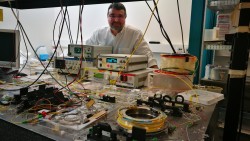Wireless connections 100 times faster than 4G
Researchers of the Valencia Polytechnic University (UPV) belonging to the Centre of Nanophotonic Technology, together with other European colleagues, have developed new infrastructure technology for 5G communications which will enable up to 100 times faster internet connections than 4G currently offers. This is the main result of Horizon 2020 TWEETHER, a European project headed by the University of Lancaster that has produced the future communication ‘arteries’ of the fifth generation. The wireless network TWEETHER is a point-to-multipoint network that works in a range that is currently not utilised, the millimetre waves of the 90 GHz frequency. The project partners have developed radio technology and manufactured the circuits and amplifier devices with a similar capacity to that of optic fibre – without requiring cables. According to the tests carried out, this transport technology could provide a capacity of over 10 Gigabits per second. “The arteries that provide coverage for 5G mobile phones of the new generation will work at very high frequencies, of over 90 GHz, which will entail great technological difficulties. There is currently no device on a commercial level that works in the 92-95 GHz range. A travelling wave amplifier has been designed during this European initiative, which would allow for the proper functioning of the 5G communication infrastructure in the millimetric wave bands across long distances,” explains Roberto Llorente, deputy director of the UPV’s Centre of Nanophotonic Technology. Therefore, with the results of this project, companies will be able to offer ubiquitous access to broadband internet. With the TWEETHER network, the user will have greater bandwidth, coverage and capacity than that offered by current wireless networks, which will make it possible to enjoy services of high added value and with great quality, both when emitting and receiving information. “To set a day-to-day example, with this technology, cuts or pixelated images during videocalls will disappear; and we will be able to enjoy 4K contents on our mobile devices,” adds Llorente. On the other hand, this new 5G infrastructure will make it possible to offer services that require a very low latency for advanced applications such as connected vehicles which won’t require large amounts of data, but it is essential for the time it takes for said data to get from one vehicle to another to be exceptionally low in the case of an emergency. Furthermore, TWEETHER will also help decrease the digital divide, which leads to millions of users worldwide – mainly in suburban or rural residential areas where optic fibre cannot be deployed – not having access to advanced services over the internet. The technology developed in this project allows the establishing of wireless coverage in broad geographical areas in a cost-effective way and in a matter of days. First worldwide transmission Partners of the TWEETHER project conducted the first worldwide transmission of data within the W band, which is between 92 and 95 GHz, in late September from the UPV. The field test was the result of more than three years of work to design state-of-the-art components and systems to activate the first point-to-multipoint wireless system over 90 GHz. Professor Claudio Paoloni, Project Coordinator and head of the Department of Engineering at the University of Lancaster, highlighted that TWEETHER has been a visionary project for the advancing of wireless communications. “The development of European technology on millimetric waves could solve two main challenges of modern communications: a way of wirelessly transmitting to and from new small 5G cells, and the digital divide that affects millions of homes, which don’t have access to broadband in areas where fibre can’t be deployed,” explains Paoloni.
Keywords
5G, TWEETHER, wireless, 90GHz, divide, cars
Countries
Spain, United Kingdom



